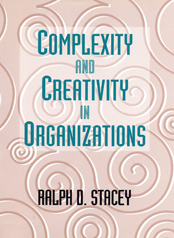Today's business environment is characterized by faster technology development and information flow, increasing interconnectedness between organizations, and the much greater diversity between people that this brings. These changes make it increasingly difficult for us foresee the consequences of our actions and stay "in control." Traditional organization theory, however, mandates that we design organizations and predict outcomes, conditioning us to assume that there is no alternative. According to this framework, we simply must foresee and stay in control, for without this there can be no order, only anarchy.
Complexity and Creativity in Organizations explains why managers in organizations cannot use projected future outcomes in action planning because future outcomes are radically unpredictable. Ralph Stacey shows how creative futures emerge from spontaneously self-organizing processes of complex learning. Complexity and Creativity in Organizations is the most comprehensive and thorough treatment of how the study and management of organizations need to change to be in tune with what we are learning from the new science of complexity. In it Stacey presents an entirely new framework for understanding life in organizations.
Combining insights from the new science with insights from psychoanalysis, Stacey posits that repressing the anxiety caused by the unstable, ever-changing nature of today's business world also represses the creative impulses-the "spaces for novelty"-that allow members of a work force to produce their best work. Organizations are creative, he says, when they operate on the edge of chaos. Thus, we should not ask how we can control the future, but rather how we can make sense of our own real, personal experience of life in organizations.
In Complexity and Creativity in Organizations , Stacey details this theory, and offers a new framework for organizations to follow. Using the science of complexity as a starting point, he pulls together many insights into behavior and organizational functioning that currently lie at the fringes of research and practice. This book invites people to explore what the new science might mean for understanding life in organizations, and shows how it can be used as a framework for understanding the processes that produce emergence rather than intentional strategies. Stacey presents an entirely new perspective on what it means for an organization to learn.
- From a pioneer in the application of the new science for understanding life in organizations
- Demonstrates what leadership means in an environment where control is impossible
- Provides a rigorous model of the learning organization that takes into account the real-life anxieties involved
Find out more about our Bulk Buyer Program
- 10-49: 20% discount
- 50-99: 35% discount
- 100-999: 38% discount
- 1000-1999: 40% discount
- 2000+ Contact ( bookorders@bkpub.com )
Today's business environment is characterized by faster technology development and information flow, increasing interconnectedness between organizations, and the much greater diversity between people that this brings. These changes make it increasingly difficult for us foresee the consequences of our actions and stay "in control." Traditional organization theory, however, mandates that we design organizations and predict outcomes, conditioning us to assume that there is no alternative. According to this framework, we simply must foresee and stay in control, for without this there can be no order, only anarchy.
Complexity and Creativity in Organizations explains why managers in organizations cannot use projected future outcomes in action planning because future outcomes are radically unpredictable. Ralph Stacey shows how creative futures emerge from spontaneously self-organizing processes of complex learning. Complexity and Creativity in Organizations is the most comprehensive and thorough treatment of how the study and management of organizations need to change to be in tune with what we are learning from the new science of complexity. In it Stacey presents an entirely new framework for understanding life in organizations.
Combining insights from the new science with insights from psychoanalysis, Stacey posits that repressing the anxiety caused by the unstable, ever-changing nature of today's business world also represses the creative impulses-the "spaces for novelty"-that allow members of a work force to produce their best work. Organizations are creative, he says, when they operate on the edge of chaos. Thus, we should not ask how we can control the future, but rather how we can make sense of our own real, personal experience of life in organizations.
In Complexity and Creativity in Organizations , Stacey details this theory, and offers a new framework for organizations to follow. Using the science of complexity as a starting point, he pulls together many insights into behavior and organizational functioning that currently lie at the fringes of research and practice. This book invites people to explore what the new science might mean for understanding life in organizations, and shows how it can be used as a framework for understanding the processes that produce emergence rather than intentional strategies. Stacey presents an entirely new perspective on what it means for an organization to learn.
- From a pioneer in the application of the new science for understanding life in organizations
- Demonstrates what leadership means in an environment where control is impossible
- Provides a rigorous model of the learning organization that takes into account the real-life anxieties involved









